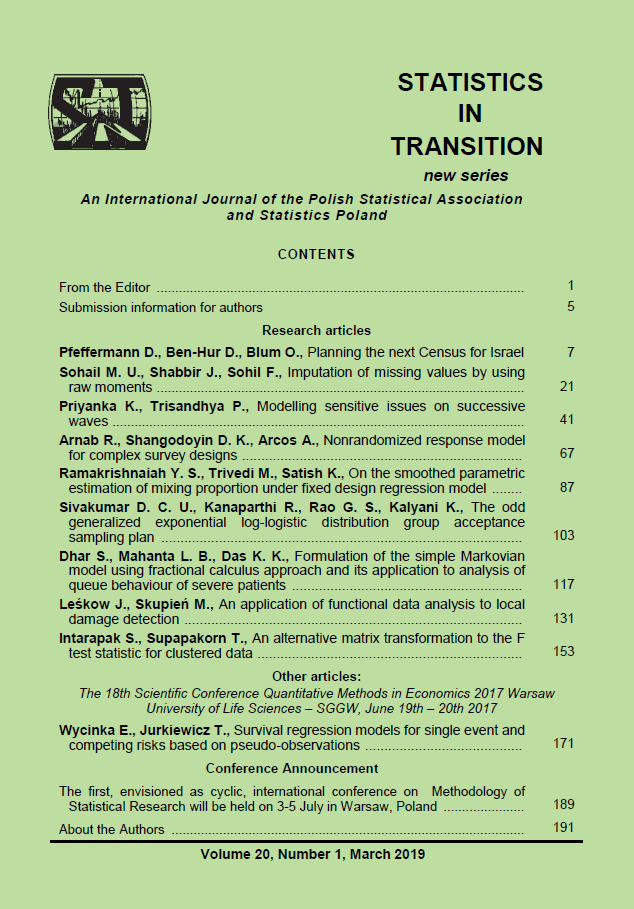ARTICLE
ABSTRACT
Warner’s randomized response (RR) model is used to collect sensitive information for a broad range of surveys, but it possesses several limitations such as lack of reproducibility, higher costs and it is not feasible for mail questionnaires. To overcome such difficulties, nonrandomized response (NRR) surveys have been proposed. The proposed NRR surveys are limited to simple random sampling with replacement (SRSWR) design. In this paper, NRR procedures are extended to complex survey designs in a unified setup, which is applicable to any sampling design and wider classes of estimators. Existing results for NRR can be derived from the proposed method as special cases.
KEYWORDS
complex survey designs, parallel model, randomized response, probability proportional to size, varying probability sampling
REFERENCES
ABERNATHY, J. R., GREENBERG, B. G., HORVITZ D. G., (1970). Estimates of induced abortion in urban North Carolina, Demography, 7, pp. 19–29.
ARNAB, R., (1990). On commutativity of design and model expectations in randomized response surveys. Communications in Statistics, Theory & Methods, pp. 3751–2757.
ARNAB, R., (1996). Randomized response trials: a unified approach for qualitative data, Commun. Statist. Theory & Methods 25 (6), p. 1173.
ARNAB, R., (2017). Survey Sampling Theory and Applications. Academic Press, Oxford.
ARNAB, R., MOTHUPI, T., (2015). Randomized response techniques: A case study of the risky behaviors’ of students of a certain University, Model Assisted Statistics and Applications, 10, pp. 421–430.
CENTRAL STATISTICAL OFFICE, (2004). Household Income and Expenditure Survey 2002/03, Republic of Botswana.
CENTRAL STATISTICS OFFICE, (2009). Botswana Aids Impact Survey III (2008), Statistical Report.
FOLSOM, S. A., (1973). The two alternative questions randomized response model for human surveys. J. Amer. Statist. Assoc., 68, pp. 525-530.
FRANKLIN, L. A., (1989). A comparison of estimators for randomized response sampling with continuous distribution from dichotomous populations. Commun. Statist. Theory and methods 18, pp. 489–505.
GOODSTADT, M. S., GRUSON, V., (1975). The randomized response technique; a test on drug use. J. Amer. Statist. Assoc., 70, pp. 814–818
GREENBERG, B. G., ABUL-ELA, A. L. A., SIMMONS, W. R., HORVITZ, D. G., (1969). The unrelated question randomized response model: Theoretical framework. J. Amer. Statist. Assoc. 64, pp. 520–539
HORVITZ, D. G., SHAH, B. V., SIMMONS, W. R., (1967). The unrelated question randomized response model. Proceedings of Social Statistical section, Amer. Statist. Assoc. pp. 65–72.
KUK, A. Y., (1990). Asking sensitive question indirectly. Biometrika 77, 436-438.
RAGHAVRAO, D., (1978). On estimation problem in Warner’s randomized response techniques. Biometrics 34, pp. 87–90.
RUEDA, M., COBO, B., ARCOS, A., (2015). Package ‘RRTCS’: Randomized Response Techniques for Complex Surveys, http://cran.r-project.org/web/packages/RRTCS/.
STATISTICS SOUTH AFRICA, (2005). Income and Expenditure of households 2005/2006, Republic of South Africa.
TAN, G.L., YU, J. W., TANG, M. L., (2009). Sample survey with sensitive questions: a non-randomized response approach, The American Statistician, 63, pp. 9–16.
TANG, M., WU, Q., TIAN, G., GUO, J., (2014). Two-sample Non Randomized Response Techniques for Sensitive Questions. Commun. Statist. Theory & Methods, 43, pp. 408–425.
TIAN, G. L., YU, J. W., TANG, M. L., GENG, Z., (2007). A new non-randomized model for analysing sensitive question with binary outcomes. Statistics in Medicine, 26, pp. 4238–4252.
TIAN, G. L., (2014). A new non-randomized response model: the parallel model. Statistica Neerlandica, 68, pp. 293–323.
WARNER, S. L., (1965). Randomize response: a survey technique for eliminating evasive answer bias. J. Amer. Statist. Assoc. 60, pp. 63–69.
WU, Q., TANG, M., (2016). Non-randomized response model for sensitive survey with noncompliance. Statistical Methods in Medical Research, 25, pp. 2827–2839.
YU, J. W., TIAN, G. L., TANG, M. L., (2008). Two new models for survey sampling with sensitive characteristics: Design and Analysis. Metrika, 67, pp. 251–263.
